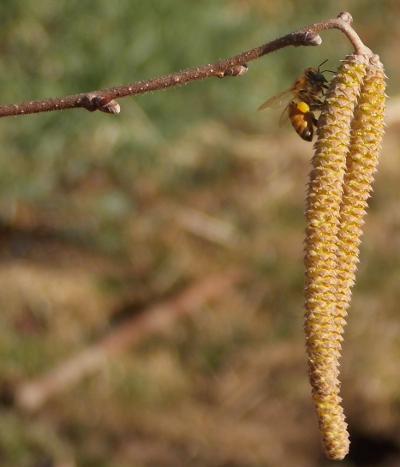
Feeding the bees in the spring
 Spring
can't come early enough if you're a honeybee, eating through winter
stores and itching for more pollen to feed your new brood. This is
the first year our hybrid hazel
has really bloomed (albeit only male flowers so far), and the honeybees
are definitely enjoying the early pollen source. Previously,
crocuses have provided the first bit of protein for our bees, so I'm
thrilled to have hazels filling in the gap during such a late spring.
Spring
can't come early enough if you're a honeybee, eating through winter
stores and itching for more pollen to feed your new brood. This is
the first year our hybrid hazel
has really bloomed (albeit only male flowers so far), and the honeybees
are definitely enjoying the early pollen source. Previously,
crocuses have provided the first bit of protein for our bees, so I'm
thrilled to have hazels filling in the gap during such a late spring.
Of course, bees need more
than pollen --- they need nectar too. Many beekeepers feed sugar
water at this time of year to simulate an early nectar flow, thus
prompting the queen to lay more eggs sooner, bulking the hive up fast so
they're ready to take advantage of the tree flowers that will open in a
few weeks.
Previously, I've tried to
only feed our bees in the fall and only then if they didn't look like
they had enough honey to make it through the winter, but I'm relaxing my
standards this spring. We only have one hive left (the barn swarm having finally bit the dust during one of those subzero spells), and I want to be able to split
it this spring. Plus, I'd really like to be able to harvest honey
--- it seems crazy that we've been raising honeybees for so long and
have still been buying (or trading for) nearly all of our honey for the
last few years. Fancy techniques for raising honeybees only make
sense if you get some yield along with the bees.
 Our
movie-star neighbor (aka my beekeeping mentor) recommends spring
feeding only if you commit to keep feeding until there are lots of
flowers around. The idea is that you don't want to get the hive
bulked up, then have a large colony starve because you stop feeding and
the spring flowers aren't open yet. To that end, I've kept a
feeder on the bees full time over the last two weeks, although they've
only eaten about 1.5 quarts so far.
Our
movie-star neighbor (aka my beekeeping mentor) recommends spring
feeding only if you commit to keep feeding until there are lots of
flowers around. The idea is that you don't want to get the hive
bulked up, then have a large colony starve because you stop feeding and
the spring flowers aren't open yet. To that end, I've kept a
feeder on the bees full time over the last two weeks, although they've
only eaten about 1.5 quarts so far.
As you can see from the photo above, our hive has a completely empty box
below their main brood chamber to expand into. We removed the
bottom board last week, so now I'll be able to keep an eye on the
colony's expansion and will report back about how the feeding campaign
impacts their spring bulk up. Only time will tell whether the
spring feeding is a good or a bad call, but I'll keep you posted either
way.
Want more in-depth information? Browse through our books.
Or explore more posts by date or by subject.
About us: Anna Hess and Mark Hamilton spent over a decade living self-sufficiently in the mountains of Virginia before moving north to start over from scratch in the foothills of Ohio. They've experimented with permaculture, no-till gardening, trailersteading, home-based microbusinesses and much more, writing about their adventures in both blogs and books.
Want to be notified when new comments are posted on this page? Click on the RSS button after you add a comment to subscribe to the comment feed, or simply check the box beside "email replies to me" while writing your comment.

I have enjoyed reading your blog the last few weeks. You do a great job on a large variety of topics. Reading about your bees reminded me of several crowded hives I once had in spite of nearly empty bottom boxes. An old timer told me that bees nearly always move up as they build hive and that queens would rarely move across incomplete comb/brood chamber to continue laying. I switched the two bottom boxes so the empty one was on top and the workers had it filled out and moved the queen up quickly. I have always since started the year with the queen in the bottom box. I don't know if this always holds up but it has worked well for me.